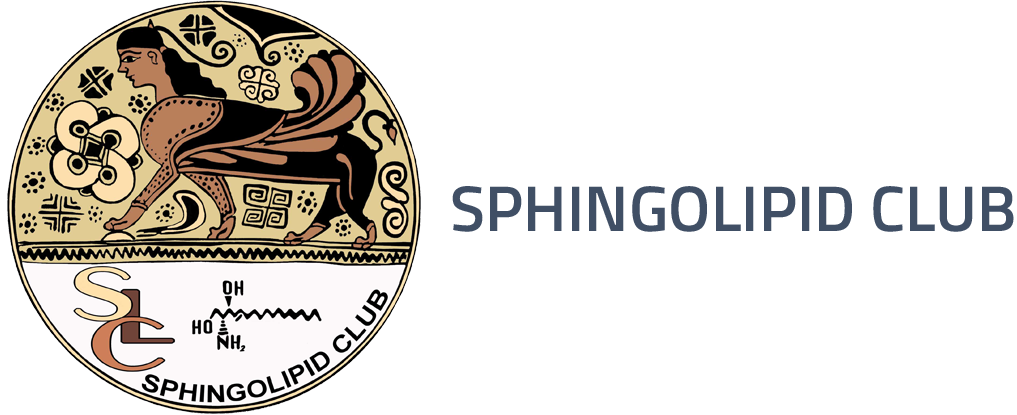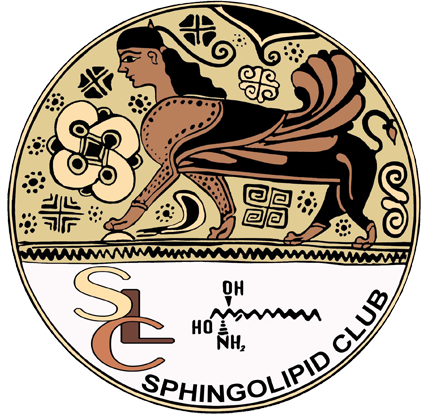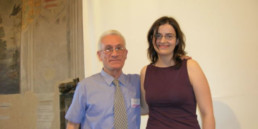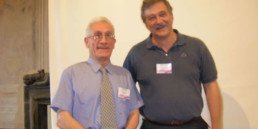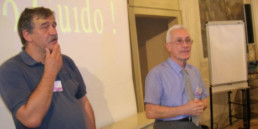4th Meeting
Bertinoro, Italy, June 9-11, 2005
The extended family of neutral sphingomyelinases.
Hannun YA
Department of Biochemistry and Molecular Biology, Medical University of South Carolina, Charleston, SC 29425
The levels of ceramide are under complex regulation by the action of a combination of enzymes whose own regulation serves to transduce the actions of stimuli into specific cell responses. Neutral(N-SMases) regulate the formation of ceramide through the hydrolysis of sphingomyelin substrates. A combination of genetic, informatic and biochemical approaches has led to the identification of a novel family of N-SMases including the yeast Isc1 and mammalian nSMase2. These enzymes share similarin vitro catalytic mechanisms and a similar requirement for anionic phospholipids. Yeast Isc1 is activated by mitochondrial anionic phospholipids, localizes to mitochondria, and participates in thepost-diauxic response of yeast cells. In human cells, nSMase2 is activated by cell-cell contact in a mechanism involving translocation to the plasma membrane. This enzyme appears to regulate the formation of specific very long chain ceramide species with suggested roles in mediating dephosphorylation of the retinoblastoma protein and the induction of cell cycle arrest in response tocell-cell contact and confluence. These results underscore the specific functions of individual pathways of ceramide metabolism in eukaryotic cell regulation.
Design and synthesis of acidic ceramidase inhibitors and their characterization using a novel fluorogenic substrate.
C Bedia1, G Triola1, S Grijalvo1,2, J Casas1, A Delgado1,2, A Llebaria1, T Levade3 and G Fabriàs1.
1Research Unit on BioActive Molecules (RUBAM), Department of Biological Organic Chemistry, IIQAB, CSIC. Jordi Girona 18. 08034-Barcelona. Spain. 2Departamento de Farmacología y Química Terapéutica, Facultad de Farmacia, Universidad de Barcelona, Unidad de Química Farmacéutica (Unidad Asociada al CSIC), Avda. Juan XXIII s/n. 08029- Barcelona. Spain. 3Laboratoire de Biochimie et Maladies Metaboliques, INSERM U466, CHU Rangueil. 1, avenue Jean Poulhes. 31059 Toulouse cedex. France.
The first step in the catabolic route of ceramide is its amide hydrolysis by ceramidases. Several types of ceramidases have been reported that differ in their optimum pH, intracellular location and substrate specificity. Mutations in the acidic form gives rise to Farber disease (1), a rare lysosomal storage disorder for which there is no current therapy. A novel strategy that has afforded promising results in Gaucher and Fabry diseases is the active site directed chaperone approach. This strategy relies on the use of competitive enzyme inhibitors at sub-inhibitory concentrations to aid the correct folding of the mutated enzyme, thus favouring its transport to the lysosome and increasing its residual activity. Although several inhibitors of ceramidases have been reported (2-4), potent inhibitors of the acidic enzyme are not available. The only acid ceramidase inhibitor so far described is N-oleoylethanolamine, and its potency is rather low (4). In contrast, potent and selective inhibitors of mechanistically similar hydrolases are known (5). Some of these inhibitors include anelectron-deficient carbonyl group that reacts with the active-site nucleophylic amino acid to form an hemiacetal intermediate, which mimics the reaction transition state thus inhibiting the hydrolysis
(6). Taking into account these studies and considering that N-acyl sphingosines with acyl chain lengths below C10 are poor substrates of the neutral ceramidase (7), two families of compounds were designed, synthesized and their activity as selective inhibitors of the acidic ceramidase was determined both in vitro and in cultured cells using a fluorogenic substrate in a 96-well plate format.
Table. Inhibition of the acidic ceramidase.
COMPOUND |
IC50 (µM) |
IC50 (µM) |
| In vitro | In cell culture | |
GT85 |
83 | 1.33 |
GT98 |
77 | 12.3 |
GT99 |
28 | 0.81 |
GT102 |
210 | 0.65 |
GT103 |
23 | 3.41 |
GT104 |
55 | 5.15 |
GT109 |
255 | 3.29 |
Among the compounds tested, a family of ketoamides exhibited inhibitory activity of the acidic ceramidase, both in enzyme preparations in vitro and in cultured Farber cells that overexpress the acidic ceramidase (Table). Kinetic studies conducted with GT85 revealed that this compound is a competitive inhibitor with a Ki of 16 µM (Figure). These ketoamides, which probably behave as reversible transition state mimics, are the first inhibitors of the acid ceramidase with potencies in the low µM range. Remarkably, these compounds have a good selectivity as compared to the neutral ceramidase in vitro, which requires around 20 fold higher concentrations for inhibition. Thus, these ketoamides are attractive candidates as chemical chaperones of potential utility in the therapy of Farber disease.
Some of the ketoamides bear a cyclopropene ring in the long chain base and have dual inhibitory activity of both dihydroceramide desaturase and the acidic ceramidase. Besides their putative usefulness as chemical chaperones, these compounds also produce a decrease of intracellular ceramide and are thus interesting as substrate reduction agents for Farber disease treatment.
References
1. He X, Okino N, Dhami R, et al., J. Biol. Chem. 2003, 278, 32978-32986. 2. Bielawska A, Greenberg MS, Perry D, et al., J. Biol. Chem. 1996, 271, 12646-12654. 3. Selzner M, Bielawska A, Morse MA, et al., Cancer Res. 2001, 61, 1233- 1240. 4. Strelow A, Bernardo K, Adam-Klages S, et al., J. Exp. Med. 2000, 192, 601-612. 5. Boger DL, Sato H, Lerner AE, et al., Proc. Natl. Acad. Sci. USA. 2000, 97, 5044-5049. 6. Koutek, B, Prestwich, GD, Howlett, et al., J. Biol. Chem. 1994, 269, 22937-22940. 7. El Bawab, S, Usta, J, Roddy, et al., J. Lipid Res. 2002, 43, 141-148.
CD1 glycosphingolipid antigen synthesis for the study of protein-carbohydrate interactions.
Panza L,1 D. Colombo,2 F. Compostella,2 L. Franchini2 and F. Ronchetti2
1DISCAFF, Università degli Studi del Piemonte Orientale, Novara, Italy
2Dipartimento di Chimica, Biochimica e Biotecnologie per la Medicina , Università di Milano, Via Saldini 50, 20133-Milano, Italy
Different classes of foreign and self lipid antigens are known to be presented by CD1 antigen presenting molecules to T cells.[1] Several studies suggest that CD1-restricted T cells perform a variety of important roles in cell-mediated immunity, although different responses have been observed after stimulation by foreign or self antigens. While the role of these proteins in bacterial infections can in general be considered clearly evaluated, their functions in the balance between the maintenance of tolerance and the development of autoimmune disease require further investigations.
Sulfatide (a mixture of 3-sulfated b-D-galactosylceramides with different fatty acids at the ceramide moiety) is one of the glycolipid antigens so far characterized that bind group I CD1 molecules.[2] Much interest is now addressed to the elucidation of the mechanism of antigen presentation. In this context a series of derivatives structurally related to sulfatide have been synthesized as pure compounds for biological assays to shed light on how differences in antigen structures can influence the activity or as probes for binding assays.
For the elucidation of the role of the lipidic moiety structure in antigen presentation, a family of sulfatides, constituents of the natural mixture and bearing palmitic, stearic, behenic or nervonic fatty acid chains, has been synthesized; these compounds have been shown to be capable of stimulating sulfatide-specific andCD1-restricted T-cell clones.[3]
In order to have a deeper knowledge of the various parameters affecting lipid binding to the different CD1 isoforms, a fluorescent sulfatide has been prepared, with a fluorophor attached on positon 6 of galactose, thus not interfering with the binding; the fluorescent probe binds to soluble recombinant human CD1a and is a valuable tool for the study of CD1 antigen binding properties.[4] Further biological tests will show if the activity of this derivative is maintained also with the other CD1 isoforms.
Finally, a b-D-galactosylceramide fully protected with selectively removable protecting groups has been synthesized; this derivative is a valuable scaffold which allows the access to a series of sulfatide related compounds, e.g. sulfated galactosylceramides differing in the position of the sulfate group on galactose for the study of the influence of the sulfate group position on T cells activation.
[1]Brigl, M.; Brenner, M. B. (2004) Annu. Rev. Immunol. 22, 817-890.
[2]Shamshiev, A.; Gober, H.-J.; Donda, A.; Mazorra, Z.; Mori, L.; De Libero, G. (2002) J. Exp. Med. 195, 1013-1021.
[3]Compostella F.; Franchini, L.; De Libero, G.; Palmisano, G.; Ronchetti, F.; Panza, L. (2002) Tetrahedron 58, 8703- 8708.
[4]Franchini L.; Compostella F.; Donda A.; Mori L.; Colombo D.; De Libero G.; Matto P.; Ronchetti F.; Panza L. (2004)
Eur. J. Org. Chem. 4755-4761.
Synthetic hydroxylated aryl-naphthalene derivatives as resveratrol rigid analogues showing ceramide-mediatedantiproliferative and pro-apoptotic properties.
Filippo Minutolo1, Giusy Sala2, Annalisa Bagnacani2, Simone Bertini1, Isabella Carboni1, Giovanni Prota1, Simona Rapposelli1, Nicoletta Sacchi3, Marco Macchia1, Riccardo Ghidoni2
1Dept. Pharmaceutical Sciences, University of Pisa – 2Lab. Biochemistry & Molecular Biology, San Paolo University Hospital, Medical School, University of Milan – 3Dept. Cancer Genetics, Roswell Park Cancer Institute, Buffalo, NY, USA
The cancer chemoprevention and the antiproliferative effect associated with dietary polyphenol resveratrol has prompted many research groups to devote their efforts in the search for new and more efficient analogues. The antiproliferative and proapoptotic properties of resveratrol have been shown to be due to an accumulation of endogenous ceramide, a pro-apoptotic natural sphingolipid, in cancer cell lines. In particular, the apoptotic cell death has been attributed more likely to the de novo synthesized ceramide, rather than to sphingomyelin hydrolysis. Moreover, the presence of phenolic hydroxy-groups have been demonstrated to be crucial in preserving this mechanism of action, since tri-O-methylated resveratrol, although showing potent growth inhibition properties in cancer cells, did not induce any accumulation of ceramide. The trans-configuration of the stilbene double bond of resveratrol also seems to be important in preserving the ceramide accumulation mediated pro-apoptotic properties.
Nevertheless, the trihydroxylated trans-stilbene chemical structure of resveratrol may undergo, as well as most stilbene derivatives, to several chemical and metabolic degradations. One well-known transformation is represented by the photochemical (E)/(Z)-isomerization of the double bond, to produce compounds of (Z)- configuration that are generally less active to inhibit cellular growth and promote apoptosis. The main metabolic reactions on stilbene derivatives involve oxidation reactions on the double bond and on theelectron-rich phenolic rings, producing highly reactive oxidized metabolites (e.g. epoxides, arene oxides, benzylic alcohols, etc.). These modifications may constitute a significant problem because in vitro biological data may be misinterpreted and, if these compounds are submitted to in vivo assays, there might be a concurrence of several metabolites to define the activity and toxicity profiles. For these reasons we decided to investigate the possibility of preparing resveratrol analogues possessing a more rigid and stable scaffold, by replacing the 4-hydroxy-styrene portion with a beta-naphthol portion. We then designed and synthesized a series of naphthalene-based resveratrol analogues, which possess either “all-free” hydroxyls, or various combinations of O-methylated OH substituents, to assess the importance of the phenolic groups also in this new class of resveratrol analogues.
The biological assays proved that the presence of a naphalene ring generally increases functional proapoptotic properties of the new molecules when compared to similarly substituted stilbene analogues. Furthermore, the concurrent presence of three hydroxyls on the phenyl-naphthalene core is still mandatory, as for resveratrol itself, to induce ceramide-mediated apoptotic cell death, since methoxy-substituted naphthalene derivatives, in spite of some good antiproliferative activity found, did not cause significant ceramide accumulation levels.
New aminocyclitols as candidates to chemical chaperone therapy for gaucher disease.
Egido-Gabás M1, Duque J2, Murillo A2 ,Canals D1, Delgado A1,3, Llebaria A1, Chabás A2, Casas J1
1Research Unit on BioActive Molecules (RUBAM), Department of Biological Organic Chemistry, IIQAB, CSIC. Jordi Girona 18.08034-Barcelona. Spain. 2Institut de Bioquímica Clínica, Corporació Sanitària Clínic, Mejia Lequerica, s/n. 08028-Barcelona. Spain. 3Departamento de Farmacología y Química Terapéutica, Unidad de Química Farmacéutica (Unidad Asociada al CSIC), Facultad de Farmacia, Universidad de Barcelona, Avda. Juan XXIII s/n. 08034-Barcelona. Spain.
Glycosphingolipids are amphipathic molecules that contain a hydrophobic moiety (ceramide) and a hydrophilic residue (sugar). They play an important role in cell recognition, proliferation and differentiation, immunorecognition and signal transduction1.
Glycosphingolipidoses are lysosomal storage diseases, a group of rare human disorders. One of them is Gaucher disease, a sphingolipidosis caused by a marked decreased in glucocerebrosidase (EC 3.2.1.45) GBA) activity. This deficiency leads to a progressive accumulation of glucosylceramide in macrophages, resulting in hepatosplenomegaly, anaemia, skeletal lesions and, sometimes, central nervous system (CNS) involvement.
The current therapeutic strategies to treat Gaucher disease involve enzyme replacement therapy (Imiglucerase, Cerezyme®, Genzyme) or substrate reduction therapy (Miglustat, Zavesca®, Actelion). However, they are expensive and relatively ineffective for CNS involvement cases2. The molecular therapeutic strategy for genetic metabolic diseases based on the use of chemical chaperones can be a promising alternative for restoration of mutant glucocerebrosidase activity3-4.
We present a new series of aminocyclitol derivatives that have been synthesized and tested as glucocerebrosidase inhibitors5. Some of them are potent and competitive inhibitors at low concentrations (Ki<3microM) of lysosomal GBA from rat liver and Imiglucerase (Cerezyme®, Genzyme6), and they are also active on the residual GBA activity present in fibroblasts of Gaucher disease patients with different genotypes (N370S/N370S, L444P/L444P, and N370S/L444P). These compounds are specific inhibitors of glucocerebrosidase since they are not inhibitors of other glucose-metabolizing enzymes (alpha-glucosidasefrom Baker’s Yeast, beta-glucosidase from Crude Almonds and microsomal glucosylceramide synthase from rat liver). They are also inactive against other lysosomal enzymes involved in ganglioside and glycosphingolipid metabolism, (beta-galactosidase, alpha-galactosidase A and N-acetyl-alpha-galactosaminidase from human fibroblasts).
Among the active compounds, three of them protect GBA from thermal denaturation. Consequently, these compounds might be considered as good candidates for a chemical chaperone therapy of Gaucher disease.
References
1. Kolter, T., Sandhoff, K. Angew. Chem. Int. Ed. 1999, 38, 1535-1568. 2. Germain, D.P., Clin. Genet., 2004, 65, 77- 86 3. Sawkar, A.R., Cheng, W., Beutler, E., Wong, C., Balch, W.E. and Kelly, J.W., PNAS, 2002, 99, 15428-15433. 4. Lin, H., Sugimoto, Y., Ohsaki, Y., Ninomiya, H., Oka, A., Taniguchi et al. Biochim. Biophys. Acta 2004, 1689, 19-228. 5.Egido-Gabás, M., Serrano, P., Casas, J., Llebaria, A., Delgado, A. Org. Biomol. Chem. 2005, 3, 1195-201. 6. A generous gift of Cerezyme® from Genzyme Corporation is gratefully acknowledged.
Membrane fusion induced by PlcHR2, a novel sphingomyelinase / phospholipase C from pseudomonas aeruginosa.
L.-Ruth Montes1, Maitane Ibarguren1, Félix M. Goñi1, Michael L.Vasil2 and Alicia Alonso1
1Unidad de Biofísica (Centro Mixto CSIC-UPV/EHU), Universidad del País Vasco, 48080 Bilbao, Spain. 2Department of Microbiology, University of Colorado, Denver, CO 80262, USA.
PlcHR2 from P. aeruginosa is a heterodimeric complex, formed by PlcH, the subunit containing the sphingomyelinase/phospholipase C active center, and PlcR2, a chaperone that modulates the catalytic activity.
PlcHR2 is the paradigm enzyme of a novel phospholipase C/phosphatase superfamily, with members in a variety of bacterial genera. In the present work we study the structural effects of PlcHR2 when acting on liposomal and cell membranes containing sphingomyelin together with other lipids. Both PlcHR2 and its separate components bind Ca2+ and, while this cation has no detectable effect on the hydrolytic activity, it inhibits PlcHR2 -induced haemolysis. In liposomes (large unilamellar vesicles) the enzyme complex inducesvesicle-vesicle fusion at similar rates, and to similar extents, in the presence and absence of Ca2+. However, this cation increases dramatically the rate of vesicle aggregation, and the rate and extent of enzyme-inducedrelease of vesicular aqueous contents (“leakage”).
Plasma membranes purified from rat liver are made mostly of detergent-resistant microdomains (lipid rafts).
Popa I1, Bionda C1, Ardail D.2, Portoukalian J.1
1Department. of Dermatology, Edouard Herriot Hospital,69437 Lyon Cx 03, France; 2Laboratory of Radiobiology, Lyon-Sud Medical School 69921 Oullins Cx, France
Plasma membranes are thought to be made of assembled detergent-resistant (rafts) and detergent-soluble(non-rafts) microdomains. However, most studies isolate lipid rafts from whole cells and very few investigations aim to determine the respective proportions of rafts and non-rafts domains in plasma membranes.
In the present study, the plasma membrane fraction of rat liver has been purified, then the raft and non-raftdomains have been isolated from the plasma membrane. Following solubilization of the membranes in TritonX-100 1%, fractions were separated by ultracentrifugation on Optiprep gradient. The specific marker proteins flottilin and glyceraldehyde-3 phosphate dehydrogenase (Gapdh) were monitored by western blot to characterize respectively the raft and non-raft domains in the fractions recovered in our experimental conditions.
Nearly 80% of the membrane proteins were in the flotillin-positive fractions. Whereas the Gadph-positivefractions contained a low amount of cholesterol, free fatty acids and phosphatidylcholine, about 90% of cholesterol and phospholipids were found in the rafts that contained also all plasma membrane-derivedsphingolipids, i.e.ceramides, neutral glycolipids, sphingomyelin and gangliosides. Our results suggest that the plasma membranes of rat hepatocytes are made mostly of domains highly resistant to the action of detergents.
Sphingomyelin and STAT3 in nuclear lipid rafts.
G. Cascianelli, M. Villani, M. Tosti, MP Viola Magni, E. Albi
Department of Clinical and Experimental Medicine, Physiopathology Section, Policlinico Monteluce, 06100, Perugia. ealbi@unipg.it
Lipid rafts are microdomains enriched in cholesterol and glycosphingolipids and are detected mainly in cellular membranes. Because of the high amount of cholesterol and sphingolipids, the fluidity of these regions is lower than the other regions of the membrane. The fatty-acid chains of lipids within the rafts tend to be extended, highly saturated and so more tightly packed, creating domains with higher order, and a new phase calledliquid-ordered phase (lo phase, Zuckermann, 1993).
Many proteins with a high affinity for the lo phase have been found in this well organised phase: GPI- anchored proteins, Src-family kinases and heteromeric G proteins.
The presence of different proteins endows to the rafts with many functions including cholesterol transport, endocytosis, protein trafficking processes and signal transduction (Moffet et al., 2000).
The demonstration of the existence of a nuclear lipid fraction highly enriched in sphingomyelin and cholesterol allowed us to hypothesise the existence of lipid rafts also in the nuclear membrane.
Therefore the aim of the present work was to study the possible presence of lipid rafts in hepatocyte nuclei. The lipid rafts were purified, after Triton X-100 treatment at 4°C, according to Danielsen (1995).
The electron microscopy analysis revealed microdomains with a typical and defined bilayer and a morphology similar to those previously studied in the cellular membrane.
The biochemical analysis showed a higher amount of sphingomyelin than that detected in other nuclear compartments, particularly the nuclear membrane. Likewise, the cholesterol content in nuclear rafts was higher than the cholesterol detected in other nuclear structures, and the ratio cholesterol-sphingomyelin is quite similar to cellular membrane lipid rafts, confirming the typical composition of these structures. Sphingomyelinase activity was also present in nuclear lipid raft.
Protein analysis evidenced many proteins of different molecular weight, with a very evident spot corresponding to a molecular weight of 90 KDa. Since sphingomyelinase is involved in STAT 3 activation, we evaluated the possible presence of this protein by immunoblotting analysis using specific antibodies. The analysis showed positivity for the signal corresponding to 90 KDa.
Thus, this protein is STAT 3, a polypeptide involved in signal transduction, able to modulate the expression of different genes involved in the cell cycle, proliferation and apoptosis. This confirms the important role that rafts can play as a platform for mediators of cell processes, also at a nuclear level. The next step will be the characterisation of the other proteins found to determine all the roles of these microdomains.
Danielsen E.M., Biochemistry 34 (1995), 1596-1605
Moffet S. Brown D.A., and Linder M.E., J. Biol. Chem. 275 (2000), 2191 – 2198
Jørgensen K., J.H. Ipsen, O.G. Mouritsen, and M.J. Zuckermann, Chem Phys. Lipids 65 (1993), 205 – 216
Regulation of cell migration by lipid phosphates and their phosphatases.
D. Brindley
Signal Transduction Research Group, Department of Biochemistry, University of Alberta, Edmonton, Alberta, Canada T6G 2S2
ABSTRACT NOT RECEIVED
Modeling and mutagenesis study of the pleckstrin homology domain of ceramide kinase.
Frédéric Bornancin, Markus Jaritz, Piroska Dévay, Siegfried Hoefinger, Philipp Rovina, Andreas Billich, Thomas Baumruker
Novartis Institutes for BioMedical Research, Brunner strasse 59, A-1235 Vienna, Austria
The N-terminus of ceramide kinase (CERK) bears a Pleckstrin Homology (PH) domain. We recently showed that this domain is essential for kinase activity and localization as well as vesicular trafficking of the enzyme1. We now used computational modeling and site-directed mutagenesis to investigate the properties of the CERKPH-domain. In silico protein folding analysis unambiguously confirmed that the N-terminal part of CERK (a.a.8-121) is best fitted to a PH-domain fold. The top hit obtained after threading is mouse Tapp2 N- terminal PH domain, and we therefore modeled CERK PH-domain on the basis of the known 3D-structure of Tapp2. Analysis of the CERK PH-domain model using Poisson-Boltzmann calculations, indicates a strong positive electrostatic potential, in line with the ability of CERK to bind membranes and phosphoinositides. InPH-domains, three variable loops, VL1, VL2 and VL3, interconnecting strands β1-β2, β3-β4 and β6-β7,respectively, provide key charged residues interacting with phosphate groups of phosphoinositides. The VL3 loop of CERK PH-domain appears to be unusually long and to play an important role, as seen from the behavior of recombinant proteins mutated within this region. Furthermore, the profile of phosphoinositide binding to the CERK PH-domain is consistent with the ability of the enzyme to readily associate with various intracellular components, e.g. Golgi complex, vesicles and plasma membrane.
1Carré et al. Biochem. Biophys. Res. Comm. (2004) 324:1215-19.
Sphingomyelin synthase 2 regulates NF-KB activation in hela cells.
Maristella Villani1,2, Young Choi1, Maurizio Del Poeta1, Y. A. Hannun1, and Chiara Luberto1
1Department of Biochemistry and Molecular Biology, Medical University of South Carolina, Charleston, SC 29425 and 2Department of Biochemical Sciences and Molecular Biotechnology, Physiopathology, Policlinico Monteluce, 06100 Perugia, Italy
Sphingomyelin synthase (SMS) represents an important class of enzymes regulating sphingolipid metabolism. In particular, SMS transfers the phosphorylcholine moiety from phosphatidylcoline onto ceramide forming sphingomyelin and diacylglycerol (DAG). Because of the ability to modulate in opposing directions the levels of ceramide, a negative regulator of cell growth, and DAG, a well-established mitogenic factor, SMS activity has been proposed to play a significant role in the regulation of those processes associated with aberrant cell proliferation. Recently, two sphingomyelin synthases, SMS1 and SMS2 have been identified. Both enzymes showed bidirectional activity when tested in vitro after expression in yeast cells, and when expressed in mammalian cells, SMS1 localized to the Golgi apparatus whereas SMS2 localized to the Golgi and plasma membrane. Our laboratory has previously shown that activation of a plasma membrane associated SMS would lead to nuclear translocation of NF-kB, a transcription factor which promotes proliferation and inflammation. Based on these observations, we investigated the function of SMS2 in mammalian cells and its role in the regulation of NF-kB activation. Treatment of Hela cells with silencing RNA (siRNA) to specifically down regulate SMS2 led to a 40-45% decrease of total SMS activity in vitro. Although no change in the mass level of DAG was found upon SMS2 down-regulation, an increase of ceramide and decrease of sphingomyelin levels were observed, suggesting a basal SMS function for SMS2 in cells. Down-regulation of SMS2 caused inhibition of basal as well as serum- and TNF-induced NF-kB activation as determined by decreased translocation to the nucleus (western blot and immunofluorescence) and DNA-binding activity (Electrophoretic Mobility Shift Assay). Finally, down-regulation of SMS2 significantly inhibited basal and induced expression of a NF-kB target gene, such as cox-2 as determined by real time PCR and luciferase reporter gene assay. All together these results suggest that SMS2 functions as a SMS in Hela cells, and participates in maintaining the molecular machinery that controls proper NF-kB activity.
∗This work was in part supported by COBRE Grant #5NIHP20RR17677 to LM Obeid (project #6 to C. Luberto; mentor, Dr James S. Norris).
Ceramide-1-phosphate: a key metabolite for regulation of cell survival.
Antonio Gómez-Muñoz1, Jennifer Kong2, Kuljit Parhar2, Sherry Wang2, Patricia Gangoiti1, Mónica González, Vince Duronio2, and Urs P. Steinbrecher2
1Department of Biochemistry and Molecular Biology, University of the BasqueCountry, Bilbao (Spain), and 2Department of Medicine, University of British Columbia, Vancouver (Canada).
Ceramide-1-phosphate (C1P) is a bioactive sphingolipid that regulates vital cellularprocesses. We first showed that C1P is mitogenic for fibroblasts, and more recently wehave demonstrated that it prevents apoptosis in bone marrow-derived macrophages.
This action of C1P involves direct inhibition of acid sphingomyelinase (A-SMase) andblockade of the caspase 9/caspase 3 pathway. Current work in our laboratory indicatesthat C1P is a potent stimulator of the phosphatidylinositol 3-kinase (PI3-K)/proteinkinase B (PKB, Akt) pathway, which is a major mechanism whereby growth factorspromote cell survival. Pretreatment of the macrophages with the selective PI3-Kinhibitors LY294002 and wortmannin blocked the inhibitory effect of C1P on cellapoptosis. However, C1P did not stimulate mitogen-activated protein kinases (MAPK), and the MAPK kinase inhibitors PD98059 and UO126 did not alter the effect of C1P onmacrophage survival. By looking into downstream effectors of PKB that might beaffected by C1P we were able to show that C1P enhanced the DNA binding activity ofthe transcription factorNF-kB. Interestingly, the selective NF-kB inhibitors, caffeic acidphenylethyl ester and SC- 514, blocked the prosurvival effect of C1P. In addition, apoptotic macrophages showed a marked reduction of Bcl-XL levels, and this decreasewas prevented by C1P. Taken together, these findings suggest that C1P blocksapoptosis, at least in part, by stimulating the PI3-K/PKB/NF-kB pathway andmaintaining the production of antiapoptoticBcl-XL.
We propose a working model for C1P in which inhibition of A-SMase and thesubsequent decrease in ceramide levels would allow cell signaling of C1P through stimulation of the PI3-K/PKB pathway to promote cell survival.
This work was supported by grants MT8630 from CIHR (Canada) and SAF-2002-03184 from Ministerio de Ciencia y Tecnología (Spain).
Relative ceramide and ceramide-1-phosphate levels: a cellular gauge for cell death during development.
Y. León1,2, T. Homan1, E.J. de la Rosa3, I. Varela-Nieto1.
1Instituto de Investigaciones Biomédicas Alberto Sols, CSIC-UAM. Arturo Duperier 4, 28029 Madrid, Spain. 2Dpto. Biología (Fisiología Animal), UAM. Darwin 2, 28049 Madrid, Spain. 3Centro de Investigaciones Biológicas, CSIC. 28040 Madrid, Spain.
Development involves the dynamic balance of cell division, differentiation and programmed cell death. The ex vivo culture of intact inner ear primordium, the otic vesicle, provides an excellent model system to study the physiological interactions among extrinsic factors during early development.
We have described the opposite actions of nerve growth factor (NGF) and insulin-like growth factor-I (IGF-I)during inner ear ontogenesis. In the otic vesicle, IGF-I is the strongest promoter of inner ear proliferation and morphogenesis, whereas NGF induces programmed cell death by binding to its low affinity p75 neurotrophin receptor (p75NTR). Activation of the p75NTR death domain triggers the generation of ceramide, the activation of caspase-3, the degradation of PARP and finally DNA fragmentation and cell death. Ceramide is generated during cellular stress and apoptosis and has been demonstrated to be a potent inductor of apoptosis within the otic vesicle neuroepithelium (Frago et al., J. Cell Sci. 116, 475. 2003). The exogenous administration of a synthetic short-chain ceramide (C2-cer) induces apoptosis in the otic vesicle. On the contrary,ceramide-1-phosphate (Cer-1-P) is a cytoprotector for otic vesicle explants, acting as a suppressor of cell death upon withdrawal of serum. Addition of Cer-1-P to otic vesicles cultures induces the phosphorylation of Akt and increases PCNA levels. Other lipidic mediators such as phosphatidic acid, sphingosine,sphingosine-1-phosphate or sphingosyl-phosphorylcholine have no appreciable survival actions on this system. NGF induces ceramide generation by activating both de novo synthesis and by increasing the activity of the acid sphingomyelinase. Both NGF- and short-chain ceramide-induced apoptosis are blocked by caspase inhibitors and by IGF-I to different extents. The protective role of IGF-I on NGF- induced cell death was accompanied by a decrease in the intracellular levels of ceramide and by the activation of the Akt kinase pathway. These results suggested that ceramide clearance by means of ceramide kinase activation could be a target of IGF-I in our system. Accordingly, IGF-I actions can be blocked by R59949, an inhibitor of lipid kinases containing a DAGK domain and RT-PCR studies show that ceramide kinase is expressed in the developing chicken otic vesicle. Being its expression up regulated at the stages crucial for cell survival and proliferation. Therefore, the conversion of the pro-apoptotic ceramide to its phosphorylated cytoprotective metabolite ceramide-1-phosphate is one of the pathways underlying the protective action of IGF-I against apoptosis induced by NGF or C2-cer.
Our data suggests that the relative levels of ceramide and ceramide-1-phosphate form part of the panel of the intracellular indicators that regulate cell death decisions during normal development.
Sphingosine-1-phosphate in human glioma cells.
Riboni L., Anelli V., Bassi R., Giussani P., Viani P., Tettamanti G.
Dept. Medical Chemistry, Biochemistry and Biotechnology, LITA-Segrate, University of Milan, Italy
Sphingosine-1-phosphate (S1P) is a bioactive sphingolipid metabolite, that plays important roles in the regulation of vital cellular processes, acting as both an intracellular messenger and an extracellular ligand for specific transmembrane receptors. As it occurs in many cells, a hallmark of S1P action in glioma cells is the induction of proliferation and protection against apoptosis, implicating S1P in glial transformation. Although information on receptor-mediated functions of S1P is available, little is known on the cell type(s) that may produce extracellular S1P in gliomas. In this study we searched for the possible origin of extracellular S1P in human glioma cells, using T98G, a human glioblastoma cell line, as model. After feeding T98G cells with tritiated sphingosine, S1P was rapidly synthesized, the majority of it undergoing degradation. In these conditions, cell medium analysis revealed the presence of extracellular radioactive S1P, whereas sphingosine kinase activity was undetectable. The extracellular export of S1P was induced by different mitogenic stimuli. In growth-stimulated astrocytes, the administration of N,N-dimethylsphingosine (a sphingosine kinase inhibitor) resulted in a significant reduction of S1P release and cell proliferation. Moreover, the administration of S1P to quiescent T98G cells was followed by the stimulation of cell growth. a rapid activation of ERK1/2, (mediated through a PTX-dependent pathway) and. In addition, we found that bEnd5, a brain-derived endothelial cell line, can release in the extracellular milieu both S1P and sphingosine kinase. The amount of S1P released from bEnd5 was markedly increased after co-culture with T98G cells. Altogether this study supports that S1P acts as an autocrine/paracrine growth factor in T98G glioma cells, and may be implicated in glial tumors.
Sphingosine kinase-1 mediates IGFBP-3 proangiogenic effects in human endothelial cells.
1,2Riccarda Granata, 3Enrico Lupia, 1,2Letizia Trovato, 1,2Fabio Settanni, 1,2Silvia Destefanis, 1,2Cristina Barbirato, 1,2Davide Gallo, 2Giovanni Garbarino, 4Riccardo Ghidoni, 2,5Giovanni Camussi, 2Ezio Ghigo
1Laboratory of Molecular and Cellular Endocrinology, 2Department of Internal Medicine and 3Clinical Physiopathology, University of Torino, Torino, Italy; 4Laboratory of Biochemistry and Molecular Biology, San Paolo Medical School; University of Milano, Milano, Italy; 5Research Center for Experimental Medicine (CeRMS), Ospedale S. Giovanni Battista, Torino, Italy.
Angiogenesis, the formation of new vessels from pre-existing vessels is a key step in developmental and pathological events, including wound healing and tumorigenesis. We have recently shown that insulin-likegrowth factor binding protein-(IGFBP)-3, the major carrier of IGF, inhibits human endothelial cell apoptosis induced by serum starvation by decreasing the proapoptotic sphingolipid ceramide. Moreover, IGFBP-3activated sphingosine kinase (SphK), that catalyses the formation of sphingosine-1-phosphate (S1P), a lipid second messenger known to inhibit endothelial cell apoptosis and to induce angiogenesis. IGFBP-3 even increased IGF-I expression, induced IGF-I receptor, Akt and ERK1/2 phosphorylation and enhanced cell motility. On the basis of the above result, we investigated the role of IGFBP-3 in human endothelial cell angiogenic signaling. We show that IGFBP-3 dose-dependently promoted capillary-like structure formation by endothelial cells on growth factor-reduced Matrigel. cDNA array analysis showed that IGFBP-3 enhanced the expression of 8 angiogenic-related genes. The use of other methods (RT-PCR, ELISA and gelatin zymogram analysis) provided further evidence of increased expression of vascular endothelial growth factor (VEGF) and matrix metalloproteinases (MMP)-2 and -9. Importantly, IGFBP-3 also increased the production ofmembrane-type 1 MMP (MT1-MMP), that plays a key role in MMP-2 activation. Decreased SphK1 expression by small interfering RNA (siRNA), blocked the proangiogenic effects of IGFBP-3 on capillary-like formation and inhibited VEGF and MMPs but not the previously observed IGF-I up-regulation. Finally, IGFBP-3dose-dependently stimulated the growth of neovessels into subcutaneous (s.c.) implants of Matrigel in vivo. We propose IGFBP-3 to be a positive regulator of angiogenesis. Moreover, we suggest that SphK1 mediatesIGFBP-3 proangiogenic effects in human endothelial cells.
Regulation of autophagy by sphingosine -1-phosphate.
Lavieu G1, Scarlatti F2, Sala G2, , Levade T3, Ghidoni R2, Botti J1, Codogno P1
1INSERM U504 Villejuif France; 2University of Milan Italy; 3INSERM U466 Toulouse France
Autophagy is a process by which cytoplasm is delivered to the lysosome and degraded. Autophagy is involved in the control of cell fate by promoting cell survival (under starvation or during cell invasion by bacterial and viral pathogens). Moreover autophagy is associated with non classical cell death under anti- tumoral treatment (as tamoxifen treatment in MCF-7 cell line).
Sphingolipid are equally involved in regulation of cell viability by an equilibrium between ceramide induced cell death and sphingosine-1-phosphate induced cell survival.
We have recently shown that ceramide is a mediator of tamoxifen induced autophagy and cell death in MCF- 7 cells (Scarlatti et al 2004 J. Biol. Chem.).
Here we show that sphigosine-1-phosphate stimulates autophagy by increasing the formation of LC3 positive autophagosomes and the rate of 3-methyladenine sensitive proteolysis without modification of the level of ceramide. Sphingosine kinase 1 (SK1) overexpression recapitulated the stimulation of S1P supplementation on autophagy. This effect was counteracted by the SK inhibitor dimethysphingosine and by expression of a dominant negative form of SK1. Dihydrosphingosine 1-P, an agonist of S1P cell surface receptors, did not stimulate autophagy supporting the notion that autophagy is mediated by the intracellular second messenger activity of S1P. In contrast to ceramide-mediated autophagy, S1P-mediated autophagy is characterized by inhibition of mTOR signaling independently of the Akt/PKB signaling arm. In contrast to ceramide, S1P did not trigger autophagic cell death. Moreover S1P-mediated autophagy has a protective effect toward the induction of apoptosis by nutrient and serum free medium. In conclusion both ceramide and SP1 are able to stimulate autophagy by different pathways with opposite outcomes on cell survival and death.
Sphingosine kinase-1 as a chemotherapy sensor in prostate adenocarcinoma cell and mouse models.
Dimitri Pchejetski1, Muriel Golzio2, Cyril Calvet1,3, Elisabeth Bonhoure1, Nicolas Doumerc1,3, Virginie Garcia1, Catherine Mazerolles4, Pascal Rischmann3, Justin Teissié2, Bernard Malavaud3, Olivier Cuvillier1
1Inserm U466, Institut Louis Bugnard, BP 84225, 31432 Toulouse Cedex 4, France ; 2Institut de Pharmacologie et de Biologie Structurale, CNRS UMR5089, Route de Narbonne, 31077 Toulouse; 3Service d’Urologie et de Transplantation Rénale, Hôpital Rangueil, TSA 50032, 31059 Toulouse Cedex 9; 4Service d’Anatomie et Cytologie Pathologiques, Hôpital Rangueil, TSA 50032, 31059 Toulouse Cedex 9, France.
Systemic chemotherapy was considered of modest efficacy in prostate cancer until the recent introduction of taxanes. We took advantage of the known differential impact of camptothecin and docetaxel on human PC-3and LNCaP prostate cancer cells to determine their effect on sphingosine kinase-1 activity and subsequent ceramide/sphingosine 1-phosphate balance, in relation to cell survival. In vitro, docetaxel and camptothecin induced strong inhibition of SphK1 and elevation of ceramide/S1P ratio only in cell lines sensitive to the drugs. Sphingosine kinase-1 overexpression in both cell lines impaired the efficacy of chemotherapy by decreasing ceramide/S1P ratio. Alternatively, silencing sphingosine kinase-1 by RNAi or pharmacological inhibition induced apoptosis coupled with elevation of ceramide and loss of S1P. Differential effect of both chemotherapeutics was confirmed in an orthotopic PC-3/GFP model established in nude mice. Docetaxel induced stronger sphingosine kinase-1 inhibition and ceramide/S1P ratio elevation than camptothecin. This was accompanied by smaller tumor volume and reduced occurrence and number of metastases. Sphingosine kinase-1overexpressing PC-3 cells implanted in animals developed – not only remarkably larger tumors – but also resistance to docetaxel treatment. These results represent the first in vivo demonstration of sphingosinekinase-1 as a sensor to chemoth.
Resveratrol affects the formation of multicellular spheroids of breast cancer cells: involvement of ceramide and adhesion molecules.
Leda Roncoroni1, Giusy Sala2, Floriana Facchetti3, Elena Dogliotti1, Nicoletta Sacchi4, Caterina La Porta3, Ersilia Dolfini1 & Riccardo Ghidoni2
1Dept Biology and Genetics and 2Lab Biochemistry and Molecular Biology, San Paolo Medical School, 3Dept of Biomolecular Science and Biotechnology, University of Milan, Italy; 4Dept Cancer Genetics, Roswell Park Cancer Institute, Buffalo, NY, USA
Resveratrol, a polyphenol present in grapes and wine, exerts a drastic growth-inhibitory effect on the human breast cancer MDA-MB-231 cell line grown in the 2D-culture. We recently described the mechanistic relationship between growth inhibitory/pro-apoptotic effect of resveratrol and de novo synthesis of ceramide [Scarlatti et al FASEB J (2003) 17,2339-41].
Here we report that ceramide mediates the growth inhibitory effects of resveratrol in MDA-MB-231 cells grown in three-dimensional (3D) cultures. MDA-MB-231 when grown in 3D-cultures can form multicellular tumour spheroids (MCTSs), which revealed an ovoid or spherical shape with well-defined and compact cells, smooth boundaries and regular surface.
First, we observed that treatment of MDA-MB-231 cells with 32 µM resveratrol significantly impaired the formation (number and size) of 3D-MCTSs. This effect correlated with a time-dependent accumulation of endogenous ceramide. In addition, cells disaggregated from the few MCTSs that were able to form MCTSs after resveratrol treatment lost their clonogenic potential.
The levels of expression of E-cadherin, N-cadherin, P-cadherin, PECAM (CD31), P-selectin and VCAM were also analysed by RT-PCR in MDA-MB231 3D-MCTSs. For E-cadherin and VCAM factors no significant expression were detected. In contrast, N-cadherin, P-selectin and P cadherin factors were expressed byMDA-MB231 cells, but 3D conditions (7 and 10 days spheroids) did not modify significantly their level of expression.
The treatment with resveratrol dramatically decreased the level of expression of N-and P-cadherin, while the level of CD31 appeared unmodified in all the growth condition (2D or 3D). Interestingly, in cells grown as spheroids resveratrol was more efficacious than in cells grown on plastic plate. In particular, 32 µM resveratrol was efficacious up to 10 days.
Thus, resveratrol can affect the formation of MCTSs by triggering ceramide-dependent pathways and modifying expression of adhesion molecules.
Cannabinoids induce apoptosis of glioma cells via ceramide- dependent up-regulation of the pro-apoptoticgene p8.
Arkaitz Carracedo, Cedric Malicet§, Ainara Egia, Cristina Blázquez, Mar Llorente, Raquel Villuendas#, M. A. Piris#, Juan L. Iovanna§, Manuel Guzmán and Guillermo Velasco
Departamento de Bioquímica y Biología Molecular I, Facultad de Biología, Universidad Complutense, 28040 Madrid Centro Nacional de Investigaciones Oncológicas, 28029 Madrid# – U624 INSERM, Campus de Luminy, Marsella, Francia§
Cannabinoids – and in particular D9-tetrahydrocannabinol (THC) – have been shown to exert antiproliferative actions both in vitro and in vivo on a wide spectrum of tumour cells. In the case of gliomas and leukaemias, this effect is – at least partially – due to the ability of these compounds to induce apoptosis of these cells via stimulation of ceramide synthesis de novo. In order to understand the molecular mechanisms underlying thispro-apoptotic effect, we have studied the gene expression profile of two sub-clones of the rat glioma cell line C6 that exhibit different sensitivity to the treatment with cannabinoids.
Our results show that one of the genes that are differentially expressed in the cannabinoid-treated sensitive cells is the stress-regulated gene p8. By using p8 siRNA and a retroviral vector to over-express this protein, we further confirmed that expression of this gene was necessary for the pro-apoptotic effect of cannabinoids to be observed in glioma cells. Interestingly, pharmacological inhibition of ceramide synthesis de novo prevented not only cannabinoid-induced apoptosis but also p8 up-regulation. Moreover, abrogation of this pathway also prevented up-regulation of several downstream targets of p8 that seem to participate in cannabinoid-inducedapoptosis.
In summary, our results suggest that treatment with cannabinoids leads to apoptosis of glioma cells via aceramide-dependent up-regulation of the pro-apoptotic gene p8.
Effect of vitamin D3 on embryonic hippocampal cells via neutral sphingomyelinase.
F Marini1, Bartoccini E1, Viola Magni M1, Garcia-Gil M2 and Albi E1,
1Department of Clinical and Experimental Medicine, Physiopathology Section, Policlinico Monteluce, 06100, Perugia. – 2Dept. of Physiology and Biochemistry, University of Pisa
Over the last ten years abundant evidence has emerged for new roles of vitamin D3. This molecule is known for its activity in calcium preservation and phosphorous homeostasis but it is also involved as a defensive agent against multiple sclerosis and in the prevention of encephalomyelitis progression, suggesting an immunosuppressive action (1). Recently, it has been demonstrated that Vitamin D3 induces erythroleucemic cell differentiation via sphingomyelinase (SMase) and prevents serum starvation apoptosis (2). Since in HN9.10e embryonic hippocampal cell serum deprivation induces apoptosis first increasing the nuclear SMase activity and after cellular SMase activity (3), the aim of the present work was to establish if vitamin D3 could have a role in slowing down the cell cycle inducing differentiation and preventing serum deprivation induced apoptosis via sphingomyelin (SM) metabolism.
HN9.10e cells were synchronized by serum free DMEM for 24h and then were grown in DMEM supplemented with 10% fetal bovine serum (FBS), 2 mM L-glutamine, 100 IU/ml penicillin, 100 µg/ml streptomycin and 2.5 µg/ml amphotericin B (fungizone). In experimental cells 400 nM vitamin D3 was added. Cells were maintained at 37 °C in a 5% CO2 humid atmosphere. Cell cycle was studied using 3H- thymidine whereas the SM metabolism was studied incubating the cells with 3H palmitic acid.
The results show that, after synchronization, the cells present two peaks of 3H-thymidine incorporation at 36 and 60 hrs respectively, corresponding to the first and second mitotic wave. Vitamin D3 does not influence behavior in time but reduces the first peak by 32% and the second by 47%, suggesting a reduction of the cell number entering in the S phase. At 48h hrs of 3H palmitic acid incorporation, the saturation conditions were reached in SM and ceramide. After this time, in the control sample the radioactivity was 45 nmol/mg protein and 35 nmol/mg protein for SM and ceramide respectively and the values did not change up to 120 min. The vitamin D3 determined a 6.6 fold increase in SM at 120 min and may influence the reduction of the S phase of the cell cycle and induce differentiation. Serum deprivation did not change the SM levels, as previously reported(3) but the vitamin D3 in these cells increased the SM levels after 30 min of treatment. The early increase of SM could play a role in preventing serum deprivation induced apoptosis.
1- A.J. Brown, A. Dusso and . Slatopolsky. Am J Physiol Renal Physiol, (1999) 277: F157-175
2- Witasp E, Gustafsson AC, Cotgreave I, Lind M, Fadeel B. Biochem Biophys Res Commun. (2005) 330:891-7.
3- E.Albi, S. Cataldi, E. Bartoccini, M. Viola Magni, F. Marini, F. Mazzoni, G. Rainaldi, M. Evangelista, M. Garcia-Gil2005 J. Cell Physiol, in press.
Sphingomyelin derivatives affect the progress of denervation of rat soleus muscle.
M.Zanin1, E. Germinario1, R.A. Sabbadini2, R, Betto3 and D. Danieli1
1Department of Human Anatomy and Physiology, University of Padova, Italy; 2Department of Biology, San Diego State University, USA, 3C.N.R. Neuroscience Institute, Muscle Biology and Physiopathology Unit, Padova, Italy.Via Marzolo 3, 35131 Padova. Tel. 049 8275305, Fax. 049 8275301
Present work is aimed at studying the effects of bioactive sphingomyelin derivatives on the progress of denervation of slow-twitch skeletal muscle. The study is based on the fact that sphingomyelin derivatives are elevated in serum so that we hypothesize they may exert trophic functions on muscles. Denervation was bilaterally performed cutting the sciatic nerve at the level of trochanter in adult rats. Sphingosine (SPH), sphingosine 1-phosphate (S1P) or sphingosylphosphorylcholine (SPC) were continuously released over soleus muscle by a mini-osmotic pump implanted subcutaneously in the scapular region and connected to the muscle through a catheter. Effects of individual sphingomyelin derivatives were evaluated on the fibre cross sectional area, myosin heavy chains composition (MHC), TUNEL-positive nuclei, and expression of MRFs. In general, either of the three lipids decrease the development of atrophy, with SPH and SPC being the most effective. However, the action of the lipids appears to be to some extent distinctive. The protective action of SPC has an early onset and is transient, while that of SPH is delayed. SPH slows down the slow- to-fast transformation of MHC isoforms normally occurring in denervation, while S1P and SPC do not seem to influence this process. SPH, S1P and SPC modulate the expression of MyoD and myogenin, suggesting that the three lipids influence satellite cells.
In general, SPH and S1P/SPC exert distinctive and opposite actions. SPH inhibits cell proliferation and promote apoptosis, while the extracellular action of S1P/SPC stimulates cell growth and protect from apoptosis. In contrast, present results show that the three lipids produce common effects, even though distinctive, on the progress of soleus muscle denervation. We speculate that the expected negative effect of SPH, that is the worsening of atrophy, is abolished by the presence at muscle fibre surface of SPH kinase, which convert SPH in S1P. Preliminary data show that in the presence of SPH kinase inhibitor, DMS, the SPH positive effect is lost. Future work will further investigate this hypothesis and the molecular mechanisms at the base of the distinctive actions of sphingolipids on skeletal muscle.
Funded by PRIN 2003, NIH, AHA and CNR.
Control of bioactive sphingolipid levels by retinoic acid receptors in breast cancer cells.
Giulia Somenzi1, Giusy Sala2, MingQiang Ren1, Manuela Amelotti1, Riccardo Ghidoni2, Nicoletta Sacchi1
1Dept. Cancer Genetics, Roswell Park Cancer Institute, Buffalo, NY, 14263, USA – 2Lab. Biochemistry & Mol Biology, San Paolo University Hospital, Medical School, University of Milan, Milan, Italy
All-trans-retinoic acid (RA) is a bioactive natural derivative of Vitamin A. RA action is mediated by nuclear RA receptors, RARs. More than one RA-receptor is involved in mediating RA-signal. RA binds RARα, which in turn regulates another RA receptor, RAR β2, with potent tumor suppressor activity. RA-resistant cancer cells often lack both RARα and RARβ2 expression. Lack of both RARs has been traced to epigenetic silencing, due to aberrant DNA methylation and histone modifications of the RARs’ chromatin. Breast cancer cells lacking both RARα and RARβ2 are unable to respond to the growth inhibitory, differentiating and apoptotic effects of RA. Biologically active sphingolipids like ceramide and sphingosine-1-phosphate (S1P) are pivotal regulators of these fundamental cellular processes. We found that sphingolipid metabolism is different in RA-resistantbreast cancer cells lacking both RARα and RARβ2 and RA-sensitive cells with intact RARα and RARβ2. We hypothesized that RARs control sphingolipid metabolism. Here we show that as a consequence of functional RARα disruption, breast cancer cells become unable of a) re-inducing RARβ2 in response to RA, b) accumulating ceramide via neutral sphingomyelinase and c) reducing the level of sphingosine kinase transcription and activity. Moreover, cells instead of being growth-inhibited are growth- promoted by RA. However, cells retain the ability of accumulating endogenous ceramide and undergoing apoptosis in response to the synthetic retinoid fenretinide, which action is RAR-independent.
The overall data lead to the conclusion that RARs control distinct sphingolipid metabolic pathways.
Activation of APP1 transcription by ipc1-dag pathway is regulated by ATF2 in Cryptococcus neoformans.
Roberta Iatta1,2, Lydia Mare2, Chiara Luberto2, Maria Teresa Montagna1 & Maurizio Del Poeta2
1Dipartimento di Medicina Interna e Medicina Pubblica Sezione Igiene, Università degli Studi di Bari, Bari, Italia – 2Department of Biochemistry and Molecular Biology Medical University of South Carolina, Charleston, South Carolina, USA
Inositol-phosphoryl ceramide synthase 1 (Ipc1) is a fungal specific enzyme that regulates the level of two bioactive molecules, phytoceramide and diacylglycerol (DAG) (1). In previous studies, we demonstrated that Ipc1 regulates the expression of antiphagocytic protein 1 (App1), a new factor involved in the pathogenicity of Cryptococcus neoformans (2). Here, we investigated the molecular mechanism by which Ipc1 regulates App1. To this end, the APP1 promoter was fused to the firefly luciferase gene in C. neoformans wild-type and in GAL7::IPC1 mutant, in which Ipc1 expression can be modulated. We found that luciferase activity is indeed regulated by modulation of Ipc1, suggesting that the lipid(s) regulated by Ipc1 may trigger APP1 transcription. Next, we investigated the role of DAGs and other sphingolipids in the activation of APP1 promoter and we found that treatment with 1,2-dioctanoyl-glycerol increases luciferase activity whereas treatment with phytosphingosine or ceramides did not affect luciferase activity. Importantly, deletion of ATF2 consensus sequence in the APP1 promoter or deletion of ATF2 gene from the genome abolishes luciferase activation by Ipc1 or DAG, suggesting that Atf2 transcription factor is sufficient and necessary for regulation of APP1 gene transcription. Since App1 is found in sera of AIDS patients affected by cryptococcosis, these studies may have important implications in understanding mechanisms of pathogenicity of C. neoformans.
References:
Luberto C, Toffaletti D, Wills E, Tucker S, Casadevall A, Perfect J, Hannun Y, Del Poeta M. Roles for inositol-phosphorylceramide synthase 1 (IPC) in pathogenesis of C. neoformans . Gene & Development 2001; 15: 201-212.
Luberto C, Martinez-Marino B, Taraskiewicz D, Bolanos B, Chitano P, Toffaletti D, Cox G, Perfect J, Hannun Y, Balish E, Del Poeta M. Identification of App1 as a regulator of phagocytosis and virulence of Cryptococcus neoformans. J. Clin. Invest. 2003; 112: 1080-1094.
The presence of the inositolphosphoceramide synthase AUR1p is critical for the survival of lac1 lag1 yeast mutants lacking the acyl-coa-dependent ceramide synthase.
Isabelle Guillas1, Vanessa Cerontola, S. Michal Jazwinski2 and Andreas Conzelmann
Department of Medicine, University of Fribourg, Switzerland and 2Department of Biochemistry and Molecular Biology, Louisiana State University Health Sciences Center, New Orleans, USA.
The lag1∆ lac1∆ double mutants lack acyl-CoA-dependent ceramide synthase and are either very sick or nonviable. Growth of lag1∆lac1∆ cells can be greatly improved by overexpression of Ypc1p or Ydc1p, two homologous alkaline ceramide hydrolases that also catalyze the reverse reaction, i.e. the condensation of free fatty acids with phyto- or dihydrosphingosine (Schorling et al., 2001; Mao et al., 2000a; Mao et al., 2000b). Overexpression of Ypc1p restores viability and growth YPK9 lag1∆ lac1∆ and allows for the synthesis of large amounts of structurally normal inositolphosphorylceramides containing fatty acids with no less than 26 C atoms. Overexpression of Ydc1p also restores viability and slow growth to lag1∆ lac1∆ cells but allows for synthesis of only small amounts of a single C26-containg non-hydroxylated inositolphosphorylceramide. The lag1∆ lac1∆ cells making only limited amounts of ceramides can during a few cell devisions in the presence of low concentrations of Aureobasidine A, a specific inhibitor of inositolphosphorylceramide sybnthase. The drug is taken up as it efficiently blocks residual inositolphosphorylceramide biosynthesis in those cells. Ultimately however, cells stop growing. Also, the AUR1 gene cannot be deleted in these lag1∆ lac1∆ cells overexpressing Ydc1p. The results indicate that the inositolphosphorylceramide synthase AUR1 remains essential in the absence of acyl-CoAdependent ceramides synthase. AUR1 may allow cells to make very small amounts of essential inositolphosphorylceramides or may serve another, unrelated, but essential function.
Involvement of bioactive sphingolipids in the postoperative intestinal trauma.
Mihaela Dragusin, Roland Broere, Sven Nätzker, Sven Wehner§, Jörg C.Kalff§, Nicolas Schwarz§, Elaine Wang*, Cameron Sullards*, Alfred H. Merrill Jr.*, Gerhild van Echten-Deckert
Kekulé-Institut für Organische Chemie und Biochemie der Universität Bonn, Gerhard-Domagk-Strasse 1, 53121 Bonn, Germany § Klinik und Poliklinik für Allgemein-, Viszeral-, Thorax-, und Gefäßchirurgie, Sigmund-Freud-Strasse 25, 53105 Bonn, Germany *School of Biology, Georgia Institute of Technology, Atlanta, GA 30332-0230,USA
There is growing evidence that inflammatory processes are accompanied by increasing levels of bioactive sphingolipids including ceramide and sphingosin-1-phosphate (S1P). Recently, a novel bioactive sphingolipid,ceramide-1-phosphate (Cer1P) has emerged as an inducer of inflammatory responses by activation of PLA2. However, no information concerning the role of these sphingolipids in inflammatory events during the postoperative intestinal trauma is yet available.
In the present study we analysed the levels of bioactive sphingolipids of mucosa and muscularis from small intestine of i) a standardized surgical rat model of intestinal manipulation, as well as of ii) lipopolysaccharide (LPS) treated rats. In addition, we have used cultured muscularis smooth muscle cells in order to investigate the bioactive sphingolipid downstream targets involved in the inflammatory cascade.
Using thin layer chromatography we detected a slight increase (up to 2 fold) of ceramide levels at 6 h and 3 h after mechanical manipulation in intestinal mucosa and muscularis, respectively, compared to sham controls. Concerning LPS treatment the increase of ceramide was less pronounced and occurred only after 24 h in both intestinal mucosa and muscularis, when compared with sham controls.
Results obtained from ESI tandem mass spectrometry (MS) measurements indicate that not ceramide but rather its metabolic products, Cer1P and S1P are increased in the intestinal muscularis, the mainly affected tissue during postoperative ileus.
Experiments performed in primary cultured muscularis smooth muscle cells indicate that both, ceramide and S1P induce an activation of cox2, a key player in inflammatory processes. Accordingly, increased levels of prostaglandins could be detected. Furthermore, using DNA chip technology, up-regulation of pro- inflammatory cytokines including IL-1 was observed.
Our latest results obtained in primary cultured intestinal smooth muscle cells concerning sphingolipid mediatedpro-inflammatory signalling cascades will be presented.
Psychotic forms of late manifesting adult metachromatic leukodystrophies : phenotype / genotype relationships.
Nicole Baumann, Benoit Colsch, Mireille Lefevre and Jean-Claude Turpin
Laboratory of Neurochimie Unité Mixte de Recherche INSERM U711-UPMC , Hopital de Salpetriere, Paris, France
Metachromatic leukodystrophy (MLD) is due to an abnormal catabolism of sulfogalactosylceramides (sulfatides)and other sulfogalactolipids (seminolipid) because of a deficient cerebroside sulfate sulfatase (arylsulfatase A i.e. ASA).Diagnosis is based on sulfatiduria and ASA determination.
In childhood this disease is multisystemic and its symptomatology and natural history is well known. Surprisingly, this genetic disease can manifest for the first time during adolescence and/or adulthood. In this case, the clinical presentation and evolutivity are very different.
Its presentation may be that of a degenerative disease of the central nervous system with mainly spastic manifestations or a spino-cerebellar ataxia, or that of a psychosis.
To try to understand this psychotic phenomena, we decided to do a complete study reviewing cases already published for which we could have more information, and also unpublished cases from clinics and laboratories including our own. Interestingly several patients were institutionalized in psychiatry departments and considered as schizophrenia. From the survey of the literature and our own experience there seems to be in opposite to infantile forms, a phenotype-genotype relationship in the adult . 10 psychotic adult cases and 3 psychotic juvenile cases responded to the classical criteria of Metachromatic Leukodystrophy, with 5- 10 % normal value, and sulfatiduria. There were common psychiatric pattern according to criteria of the DSM4 for Schizophrenia: delusions, hallucinations,disorganized behavior, affective flattening, social occupational dysfunction. This was associated to cognitive deficiency. Many years could occur till neurological manifestations became evident. Molecular studies were performed both by PCR restriction and sequencing. Motor forms involve the major adult mutation P426L in a homozygote form in contrast to psychocognitive forms which involved as a compound heterozygote a specific I179S mutation of ASA, the second mutation being mainly of the infantile type The I179S mutation was present as a compound heterozygote in the 13 psychiatric cases we studied. Possibly other mutations are also involved in psychiatric cases but I179S is the major one and there is definitely a phenotype/genotype correlation.
Human sialidases: molecular biology, biochemistry and physiopathological implications.
OVERVIEW LECTURE
Guido Tettamanti
Department of Medical Chemistry, Biochemistry and Biotechnology, The Medical School, University of Milan, Via F.lli Cervi 93, 20090 Segrate, Milan, Italy
Sialidases are expressed in viruses, bacteria, protozoa and vertebrates. Viral and bacterial sialidases display about 35% homology in their primary structure, and share some specific motifs: six four-stranded antiparallelβ-sheets arranged as the blades of a propeller; a F(Y)RIP motif located toward the aminoterminal region, a repetitive motif SXDXGXXT/W in the active site region; and some Asp-boxes. In mammalian (including human) organs and tissues, sialidases display different subcellular locations (lysosomes, plasma membrane, cytosol and, possibly, other locations) and substrate specificities. The lysosomal, cytosolic and plasma membrane sialidases, also from the same animal, have different protein structure, antigenic properties and cDNAs.
The following human sialidases have been cloned so far: the lysosomal sialidase NEU1 coded by NEU1 gene mapped in 6p21, the cytosoluble sialidase NEU2 coded by NEU2 gene mapped in 2q37, the plasma membrane bound sialidase NEU3 coded by NEU3 gene mapped in 11q13, and the newly discovered sialidase NEU4 coded by NEU4 gene mapped in 2q37. The corresponding recombinant sialidases constitute powerful tools for studying the structure-function relationships of these enzymes. As an example, recombinant human cytosolic sialidase (Hs NEU2), expressed in E. Coli, was purified to homogeneity and its crystal structure defined. The presence of the canonical six blades β-propeller structure, F (Y)RIP motifs and three Asp- boxes, typical of all studied sialidases, was confirmed. In addition, with the use of the inhibitor DANA (2,3–dehydro–3–deoxy–N–acetylneuraminic acid) the dynamic nature of substrate recognition was assessed. Recombinant Hs NEU2 was proven to differentially recognise: (a) the type of sialosyl linkage (the α 2-3sialosyl linkage to galactose is preferred); (b) the aglycone part of the substrate (gangliosides act as the best substrates); and (c) the supra-molecular organization (monomer, micelle, vesicle) of the ganglioside substrate. The latter ability might be relevant in sialidase interactions with gangliosides under physiological conditions.
Some plasma membrane bound sialidases appear to be attached to the membrane via a glycan- phosphoinositide (GPI) anchor, possibly indicating their location in specialized plasma membrane “domains” (lipid rafts). Surface sialidase NEU3 is able to affect sialoglycolipids exposed on the surface of vicinal cells and was shown to be directly involved in neural and myoblast differentiation. In the latter case the block of sialidase expression led to inhibition of the differentiation toward myocytes. Sialidases appear also to be involved in human erythrocytes maturation and ageing under physiological and pathological conditions. Very recent results point to the implication of sialidase NEU3, and its hydrolysis products gangliosides GM1 and GM2, in the insulin post-receptor signaling events, and of sialidases NEU2 and NEU3 in tumor growth. The genetic lack of sialidase NEU1 is responsible of a very severe lysosomal disease.
Resveratrol sensitization of DU145 prostate cancer cells to ionizing radiation is associated to endogenous ceramide increase.
Scarlatti F., Maioli C.$, Sala G., Maffei R., Milani F.$, and Ghidoni R.
Lab Biochem & Molecular Biology – San Paolo University Hospital, Medical School,
$ Institute of Radiological Sciences, University of Milan, Milan
Radiotherapy is an established therapeutic modality for prostate cancer. Since it is well known that the restriction of radiotherapy is its severe toxicity on normal cells at high dose and minimal effect at low dose. The search for biological compounds able to increase the sensitivity of tumors cells to radiation may improve the efficacy of therapy. Resveratrol, a natural antioxidant, was shown to inhibit carcinogenesis in animal models [1], and to block the process of tumor initiation and progression [2]. The purpose of this study was to examine whether resveratrol can sensitize DU145, an androgen-independent human prostate cancer cell line, to ionizing radiation (IR).
We observed that, although DU145 cells are relatively sensitive to IR-induced cell death, pretreatment with resveratrol significantly enhances tumor cell death induced by IR alone. Resveratrol acts synergistically with IR to inhibit colony formation of DU145 cells in vitro. Moreover resveratrol potentiates IR-induced ceramide accumulation in DU145 cells. We supposed that the clonogenic survival of DU145 cells after combined treatment of resveratrol with IR is associated to the generation of ceramide. The synergistic effect at biologically relevant doses of radiation (0.5-2 Gy) suggests that the combination of resveratrol with IR allows reduction of radiation doses and potentially reduce treatment-related morbidity.
1.Yang CS. et al. Inhibition of carcinogenesis by dietary polyphenolic compounds. (2001), Annu. Rev. Nutr. 21:381-406.
2.Jang M. et al. Cancer chemopreventive activity of resveratrol, a natural product derived from grapes. (1997)Science 275: 218-220.
Effect of dexamethasone on cellular and nuclear sphingomyelin- synthase.
Tringali A. R., Tringali S. , Viola Magni M.P., Albi E.
Department of Clinical and Experimental Medicine, Physiopathology Section, Policlinico Monteluce, 06100, Perugia.
It has been determined that glucocorticoids are essential for cell growth in culture acting upon receptors, enzyme activity and membrane transport (1). On the other hand, these molecules induced growth inhibition and lysis in certain sensitive leukemic cells (2) and apoptosis in mature, activated, peripheral T lymphocytes
(3). The induction of apoptosis could be one of the key mechanisms mediating the therapeutic effect of glucocorticoids in the treatment of leukemias, lymphomas and various autoimmune disorders.
The biological effects of dexamethasone were generally thought to be mediated by an intracellular protein receptor which transduces the hormone signal to the nucleus and participates directly in gene regulation (4). Recently, we have demonstrated that dexamethasone inhibited the growth of lymphoblastic lymphoma cells(SUP-T1) by stimulating the cellular sphingomyelinase (SMase) activity and inhibiting the nuclear SMase activity after two hours of treatment (data not shown). This effect induced an increase in cellular ceramide and a reduction in the nuclear ceramide pool enriching sphingomyelin (SM) in the nucleus. Since the SM- synthase activity was present in the nuclei, the aim of this work was to establish the possible effects of dexamethasone on cellular and nuclear SM-synthase activity in tumor cells. To this end, the lymphoma cells (SUP-T1) were seeded in RPMI 1640 in the presence of 10% fetal bovine serum, at the concentration of 100.000/ml and cultivated up to 6 days in a 5% CO2 humid atmosphere. Two 5% lots were prepared: one control and one cultivated in the presence of dexamethasone (500 µg/ml). The SM-synthase activity was assayed in the homogenate and nuclei by using 3H-phosphatidylcholine as substrate. The results show that in the homogenate the SM-synthase activity is 10 pmol/mg protein/min at 0 min, increases of 80 times after 30 min, then decreases slowly until 2 hours and after remains constant for all considered times. In the nuclei,SM-synthase activity is inhibited by 50% compared to the control after 30 min and then increases progressively up to 2 hours. In conclusion the nuclear SM metabolism is independent from that of in the whole cell and the SM-synthase activity contributes to the SM enrichment pool after two hours of dexamethasone treatment. Since it has been postulated that SM acts on chromatin structure, it is possible that dexamethasone induces apoptosis by enriching the nuclear SM pool and favouring chromatin destabilization.
(1)Nelson DH, Murray DK., Proc. Natl. Acad. Sci. USA. 1982 Nov. 79: 6690-6692.
(2)Yuh YS, Thompson EB., J Biol Chem. 1989 Jun 25; 264(18): 10904-10.
(3)Galili U, J. Steroid Biochem. 1983 ; 19: 483-490.
(4)McEwan IJ, Wright APH, Gustafsson JÅ, BioEssays 1997 ; 19: 153-160
Role of sphingosine kinase 1 in the regulation of proliferation and autophagy in myeloid leukemia cells.
Ricci C.1,2, Sala G.1, Onida F.3, Soligo D.3 and Ghidoni R.1
1Lab Biochem & Molecular Biology – San Paolo University Hospital, Medical School, University of Milan, 2Fondazione Matarelli, Milan, 3IRCCS Ospedale Maggiore and University of Milan
Sphingosine Kinase 1 (SK1) is a key enzyme of the sphingolipid metabolism. By phosphorylating sphingosine (Sph), it induces intracellular accumulation of sphingosine 1 phosphate (S1P). As a second messenger, S1P stimulates proliferation and survival and protects cells against ceramide-induced apoptosis [1]. Although oncogenic activity of SK1 has been demonstrated in solid tumors [2], its role in the proliferation of leukemia cells remains unclear. In particular, we aimed to investigate SK1 involvement in cell growth regulation of chronic myeloid leukemia (CML), an hematopoietic disorder characterized by the malignant expansion of bone marrow pluripotent stem cells. The fusion protein Bcr/Abl, through its constitutive tyrosine kinase activity, is the pathogenetic event that causes CML and thus specific inhibitors have been developed. Among those, Imatinib Mesylate (IM) represents a successful strategy in CML treatment. However, most patients who are treated in advanced stages of the disease relapse after an initial response to IM. Therefore, the existence of a functional link between Bcr/Abl and SK1 would provide alternative targets to develop new strategies to overcome acquired resistance to IM in CML.
Recently, the ERK1/2 and PI3K/AKT pathways were shown to be activated by SK1 overexpression [3]. Those molecules are involved also in the negative control of macroautophagy [4], a constitutive cellular mechanism for the turnover of organelles and long-lived proteins. According to the activating signal, increased autophagy can lead to either cell survival or death. First evidences showed a decrease of autophagic activity in tumor cells, but its exact role in oncogenic transformation needs to be clarified. Autophagosome formation requires the recruitment of Beclin-1, which is the product of a tumor-suppressor gene frequently deleted in human cancer, and LC3, marker of autophagic vacuoles. We aim to investigate the contribution of autophagy to CML proliferation and to define whether there is any relationship between this process and SK1.
As an in vitro model, we used a panel of CML cell lines (KU-812, K562, RWLeu4 and AR230) and evaluated the basal expression level of SK1, Beclin 1 and LC3 by semi-quantitative RT-PCR. Afterwards, the effect of increasing doses (0, 1, 5 and 10 µM) of a novel SK1 inhibitor was determined at different time points (0, 24, 48 and 72 hrs) on cell proliferation and viability. Preliminary results showed that pharmacological inhibition of SK1 caused a decrease of the percentage of viable cells, suggesting that this kinase may play a role in the growth of leukemia cells.
After establishing the IC50 of SK inhibitor for each cell line, the correlations between SK1 and Bcr/Abl will be investigated by treating cells with both SK1 inhibitor and IM. In particular, possible changes in the expression of mRNA and protein together with the kinase activity will be evaluated. Under the same conditions, we will also explore whether autophagy is consequently modulated.
References
1.Cuvillier O et al, Nature, 381: 800-3, 1996
2.French KJ et al, Cancer Res, 63: 5962-9, 2003
3.Lescolan E et al, Blood (published online), 2005
4.Arico S et al, J Biol Chem, 276 (38): 35243-6, 2001
Different ceramide-mediated cell responses to drugs in prostate cancer cells.
Roberta Maffei, Giusy Sala & Riccardo Ghidoni
Lab Biochem & Molecular Biology – San Paolo University Hospital, Medical School, University of Milan
The sphingolipid ceramide is an important bioactive lipid that regulates diverse signaling pathways involving apoptosis, cell senescence, cell cycle and differentiation. It can be generated through different pathways. The various biosynthetic pathways seem to reflect the distinct cellular compartments where ceramide is localized, and to lead to different cellular responses.
Our purpose is to correlate ceramide increase with i) its way of generation, and ii) the biological cell outcome. In this perspective we assayed a panel of different drugs to induce endogenous ceramide increase inandrogen-sensitive prostate cancer cell line (LNCaP).
Celecoxib, CoCl2, doxorubicin, etoposide, fenretinide (4-HPR), resveratrol and tamoxifen have been used. Treated LNCaP have been evaluated for cell growth, induction of apoptosis and ceramide accumulation.
All drugs, with the exception of tamoxifen, decreased viability. Growth curves showed a dose-dependentinhibition of proliferation for each treatment.
With celecoxib, CoCl2, etoposide, 4-HPR and resveratrol we observed a small increase in intracellular ceramide, which is dose-dependent only with 4-HPR.
Ceramide increase is not followed by PARP cleavage, with the exception of 4-HPR, and DNA laddering formation, in a wide concentration range.
These preliminary results suggest that i) the LNCaP biological response to different drugs is not significantlyceramide-dependent, ii) only 4-HPR unequivocally induces apoptosis and this is associated with ceramide increase. The LNCaP genotype (i.e. this cell line exhibits acid ceramidase overexpression [1]) may explain the modest correlation between ceramide accumulation and cell response.
Reference:
[1] Seelan RS, Qian C, Yokomizo A, Bostwick DG, Smith DI, Liu W. “Human acid ceramidase is overexpressed but not mutated in prostate cancer.” Genes Chromosomes Cancer. 2000;29:137-46.
Anti-sphingomyelin antibodies in oncologic patients.
Pugliese L., Bernardini I., Viola Magni MP., Albi E.
Department of Clinical and Experimental Medicine, Physiopathology Section, Policlinico Monteluce, 06100, Perugia.
Antiphospholipid (aPL) antibodies are a heterogeneous group of immunoglobulins1 that exhibit a broad range of target specificities and affinities, all recognizing various combinations of phospholipids, phospholipid-bindingproteins or both and phospholipid- protein complexes. It is known that the high values of Antiphospholipid (aPL) antibodies are indices of Antiphospholipid Syndrome 2 characterised by vascular thrombosis, recurrent pregnancy loss and thrombocytopenia. Recently, the aPL antibody positivity was observed in patients with leukaemia, lymphoma and monoclonal gammopathy3-5.
The aim of this work was to study the possibility of the aPL antibody positivity in patients with solid cancers in which other classic tumour markers were positive.
First, according to the immunoassay currently performed, we used the ELISA Test (ALFA WASSERMANN,Cardiolipina-aK Combi test). Since anticardiolipin antibodies are believed to be polyspecific antibodies thatcross-react with all the anionic phospholipids6, we also proposed the use of phatidylinositol and sphingomyelin as antigens.
Fifty six patients entered the study (35 F; 21 M) average age 62 yrs (range 30-92) with high tumour markers levels (CEA; CA 19.9; Ca 125; CA 15.3). None of the patients had SLE or other conditions known to be associated with aPL antibodies such as chronic infections, recent acute bacterial or viral infections. Patients with inherited causes of venous hypercoagulability (protein C/S, antithrobin III deficiencies) were excluded. As control, 48 healthy donor blood was used. Serum samples were stored at –20 ° C until used.
The results showed that 28 of 56 patients (50.0%) were aPL positive and 25/28 (89.0%), 45% of all patients, had moderate or high antiphospholipid antibody levels. In particular we noticed a positivity for aPL antibodies in patients with high levels of CA 19.09 (6/7 corresponding to 85,7%) or CEA plus CA19.09 (8/10 corresponding to 80%). Nevertheless we also detected a strong association between aSM antibodies and these markers compared to aCL and aPI antibodies. In fact, the results showed that in patients with high level of CEA plus Ca19.09, the IgG positivity was 3/10 (30%) for the CL and PI and 6/10 (60%) for the SM and the IgM positivity were 1/10 (10%) for the CL and PI and 3/10 (30%) for the SM. In patients with Ca19.9 we noticed an IgG positivity for the CL 3/7 (42,8%), for the PI 4/7 (57,1%) and for the SM 3/7 (42,8%), the IgM positivity resulted 0/7 for the CL and PI and 3/7 (42,8%) for the SM.
1.Hughes GRV BMJ 1983; 287: 1088; 2. Jerrold S. Levine M.D., Ware Branch M.D and Joyce Rauch PH.D NEJM, 2002, Vol.346, No.10; 3.Soltez P.,Szekanec Z., Vegh J., Lakos G., Toth L., Szakall S., Veres K., Szegedi G. Haematologia 2000; 30 (4):303-11; 4. Asherson RA, Khamashta MA, Ordi-Ros J, et al. Medicine (Baltimore)1989;68:366-74. 5. Vianna JL, Khamashta MA, Ordi-Ros J, et al. Am J Med 1994;96:3-9.Galli M, Comfurius P, Maassen C, et al. Lancet 1990;335:1544-7.
Effect of energetic stress and the ceramide analogue C6-ceramide on thyroid oncocytoma cell lines.
A.M.Porcelli, A.Ghelli, L.Iommarini, M. Hoque, C. Zanna, V.Carelli*, G. Romeo§ and M.Rugolo
Dip. di Biologia Evol. Sperim.; *Dip. di Scienze Neurologiche and §Dip. di Medicina Interna, Cardioangiologia, Epatologia, Università di Bologna
Thyroid oncocytomas or Hürthle cell tumours (HCT) are characterized by a specific cytoplasmic eosinophilia. This reflects the abundance of mitochondria, which leads to the typical oxyphilic phenotype. Previous biochemical studies have suggested that a mitochondrial dysfunction might underlie HCT (1, 2). Recently, a high frequency of mtDNA mutations in complex I and IV genes has been shown to be involved in thyroid tumours (3, 4), suggesting that a coupling defect in oxidative phosphorylation might be a cause of compensatory mitochondrial hyperplasia in these tumours (5, 6). In order to study the bioenergetic efficiency of mitochondria in HCT we have determined cell growth in a medium where glucose is substituted by galactose. Under these conditions, the rate of glycolysis is greatly reduced and cells are forced to rely only on mitochondria for ATP production. Experiments have been carried out with the XTC-1 cell line (thyroid follicular oxyphilic cells) and the TPC-1 cell line (thyroid papillary carcinoma with no oxyphilic feature). In galactose medium, the TPC-1 cells were able to grow, albeit at a slower rate than in glucose medium. XTC-1 cells on the other hand exhibited a significant decrease in both cell viability and ATP levels. These results suggest that a severe energetic impairment exists in XTC-1 cells, which is likely to be responsible for the compensatory mitochondrial proliferation.
In contrast to the cell death observed in galactose medium, XTC-1 cells were resistant to the toxic effect of the ceramide analogue C6-ceramide (20µM). The ATP content of these cells was maintained after treatment with the ceramide analogue, whereas the ATP level of TPC-1 cells was remarkably reduced. However, both cell lines appeared to be stressed, in particular the mitochondrial network, evaluated after loading with the specific dye Mitotracker Red, was found to be dramatically fragmented and swollen. We observed that Lysotracker Red, which specifically accumulates in the acidic compartments and lysosomes, was significantly increased in XTC-1 in comparison to TPC-1 cells. Our hypothesis is therefore that an autophagic process might be constitutively activated in the oxyphilic cell line, perhaps as a result of the mitochondrial energetic impairment. To investigate this specific issue, we will determine the effect of specific inhibitors of autophagy, such as 3-methyladenine (10mM) and wortmannin (100nM) on both cell viability and ATP levels ofC6-ceramide-treated XTC-1 cells. Furthermore, the incorporation of the fluorescent dye monodansylcadaverine, a specific marker for autophagic vacuoles (7), will be utilized to quantify the changes occurring in these organelles during incubation with the ceramide analogue. These preliminary results suggest that XTC-1 cells incubated with C6-ceramide might represent a useful model with which to investigate the autophagic process.
1.Tallini G. (1998) Virchows Arch. 433:5-12.
2.Maximo V. et al. (2000) Virchows Arch. 437:107-115.
3.Maximo V. et al. (2002) Am J Pathol. 160:1857-1865.
4.Rogounovitch T. et al. (2004) Endocr J. 51: 265-277.
5.Savagner F. et al. (2001) Thyroid 11: 327-333.
6.Savagner F. et al. (2001) J Clin Endocrinol Metab. 86:4920-4925.
7.Munafò D.B. and Colombo M.I. (2001) J. Cell Sci. 114, 3619-3629
This work is supported by a grant from AIRC.
Regulation of ceramide metabolism in glioma cells: evidence on the role of phosphatidylinositol- 4-kinases.
T.Colleoni, L. Brioschi, P. Giussani, V. Anelli, R. Bassi, L. Riboni, G. Tettamanti and P.Viani
Dept. Medical Chemistry, Biochemistry and Biotechnology, Faculty of Medicine, University of Milan, Italy
A great number of evidence supports the role of ceramide (Cer), a key intermediate of sphingolipid metabolism as signalling molecule in mechanisms governing growth, differentiation and death in many cell types including glial cells. Different studies demonstrate that in glial cells Cer exerts antiproliferative and proapoptotic effects, and strongly support that Cer-signaling is altered in glial tumors. The control of Cer levels is a very complex process which involves both specific enzymes localized in different subcellular compartments and the regulation of Cer intracellular movements. Recent evidence suggests that the biological effects exerted by Cer depends on the variation of Cer levels in specific subcellular compartments, therefore correlated to the regulation of its intracellular traffic. Notwithstanding the mechanisms involved in Cer transport play a crucial role in Cer metabolism and signalling, the information on this process is very limited. Recently, a protein (CERT) that acts as ceramide carrier protein between endoplasmic reticulum (ER) and Golgi apparatus and is involved in sphingomyelin (SM) biosynthesis has been identified. The amino-terminal region of CERT contains a pleckstrin homology (PH) domain with selectivity towards phosphatidylinositol-4-phosphate (PI4P), to allow its targeting to the Golgi apparatus. In addition, recent evidence demonstrates that the interaction ofoxysterol-binding protein (OSBP) with ER and Golgi apparatus is regulated by its PH domain and is involved in the vesicle -mediated Cer transport from ER to the the Golgi for SM biosynthesis. This suggests the possibility that phosphoinositides, in particular PI4P a lipid known to be enriched in Golgi membranes, contributes to the regulation of ceramide metabolism and signalling. A number of different isoforms ofPI4-kinase (PI4-K) have been characterized. The isoenzymes differ from subcellular distribution and sensivity to inhibitors. Most of the isoenzymes are inhibited by phenylarsine oxide (PAO), whereas only the class IIIPI4-Ks, mainly associated to Golgi membranes, are sensitive to wortmannin (WT).
In the present study we investigate the effect of PI4-Ks on ceramide metabolism and traffic in C6 glioma cells. Treatment of C6 glioma cells with both PAO and WT results in a dose-dependent decrease of phosphatidylinositol phosphorylation. In pulse/chase experiments with 3H-sphingosine both inhibitors promote a dose-dependent increase of 3H-Cer with a concomitant decrease of 3H-SM and in a lesser extent of 3H-glucosylceramide. Metabolic experiments performed with N-hexanoyl-[3H]sphingosine and 3H-SM allow to exclude an effect of PI4-K inhibitors and/or polyphosphoinositides directly on SM-synthase, SMase orglucosylceramide-synthase activity. Moreover, PI4-K inhibitors strongly affect the intracellular distribution ofBODIPY-Cer. In fact in cells treated with WT and PAO the accumulation of the fluorescence in the perinuclear region representative of the Golgi apparatus was strongly reduced. Staining with NBD Cer a specific marker of the Golgi demonstrate the integrity of Golgi apparatus in WT and PAO treated cells.Taken together these results strongly suggest that the inhibition of a PI4-K localized in the Golgi apparatus impairs the biosynthesis of sphingomyelin and in a lesser extent of glucosylceramide, possibly reducing the dockng sites, namely PI4P, for ceramide targeting to the Golgi apparatus. This could represent a further element in the cross-talkbetween phosphoinositides and sphingolipid signaling involved in the control of glial cell fate.
